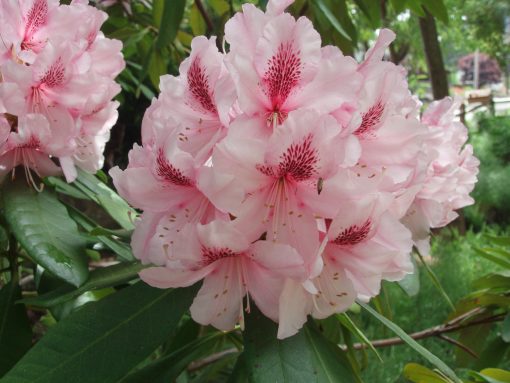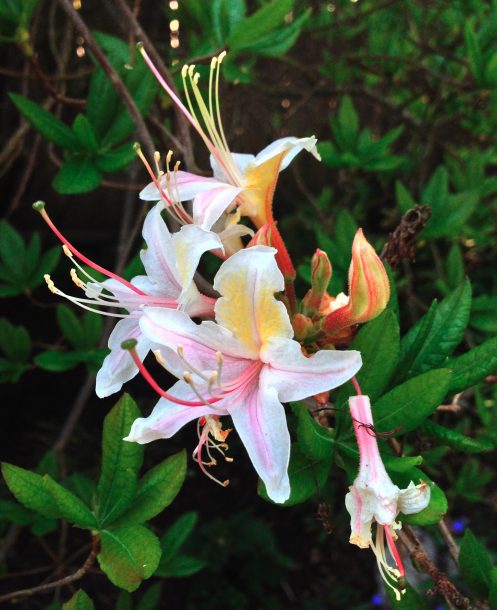
Rhododendrons are one of spring’s show stoppers. Huge, rounded clusters of stunning blossoms in lavender, red, purple, white, pink and even yellow and gold clothe these shrubs with color. You can have flowers from February to late May by choosing different varieties. And rhododendrons are easy to grow if you give them what they need.
Rhododendrons like air in the root zone so amend your soil liberally with organic matter. 50-60% is not too much. If you garden in clay, just plant them in raised beds or berms 1-2 ft above the original soil level. Rhododendrons like moist soil so top dress around your plants with several inches of mulch over the root zone, making sure the stem is not get buried. Pine needles, oak leaves or wood chips are good choices. Never cultivate around the plants as this would injure the surface roots. Finally, most rhodies thrive in partial shade or morning sun. The hot afternoon sun that we get during the summer would burn even those varieties that tolerate some sun. Since their leaves remain on the plant for several years you’d have to live with burnt leaf centers and edges for a long time if they get too much sun.
Because rhododendrons contain toxic resins that are more concentrated in the foliage, weevils have developed a resistance to pesticides along with a tolerance for the toxins in the leaves. Organic or even chemical sprays have little effect anymore according to a study funded by the Rhododendron Society of America and end up killing hundreds more predatory beetles and other beneficial insects in the process.
Applying parasitic nematodes to your soil is one way to control weevils. Other tactics include placing a shallow pan of water under the plant or a soup can filled with soapy water buried up to the top to attract and drown the adults . You can also try banding the trunks with tape or waterproof paper and smearing the bands with a sticky barrier like Tanglefoot. Spreading some coffee grounds under the plants also helps to discourage them from crawling up the trunk after they spend the night at the base of the plant. And if you’re really determined you can hand pick them after dark- effective but not much fun.

There are thousands of rhododendron varieties. By planting early, mid-season and late blooming types you can enjoy those huge, gorgeous flowers for months.
Cheer is one of the showy early bloomers. Large, pink flower trusses cover the 5×5 ft plant. It can take some sun and would be a good candidate if you have one of those gardens that receives and hour or so of afternoon sun.
For April blooms consider Edith Bosley. Similar to Purple Splendor it grows upright to 6 ft.tall but only 4 ft wide. Perfect for narrow spaces. Other mid-season bloomers that would make a splash in the garden include Golden Gate, a 3 ft compact orange hybrid and easy-to-grow, red-flowering Jean Marie de Montegue.
To extend your season add some late season varieties like Lee’s Dark Purple. Growing with a spreading habit to 4 x 5 ft wide, you’ll love its blue-purple trusses. Anah Kruschke also blooms late in spring with lavender pink flowers on a dense 5 x 5 ft shrub. A tough undemanding larger variety is English Roseum. This one grows 6 ft tall with lavender pink flower trusses and blooms in May.
Rhododendrons really contribute to the woodland or shade garden. They are long-lived and deer resistant. I’ve only heard two gardeners tell me that deer ate some of their flower buds last fall for the moisture content. Most likely those deer couldn’t read well enough to read the deer resistant list!
